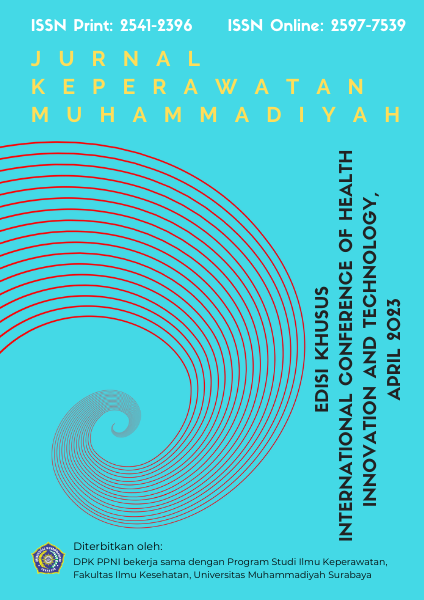MOTHER'S KNOWLEDGE ABOUT LACTATION AMENORRHEA METHOD (LAM) OF BREASTFEEDING
DOI:
https://doi.org/10.30651/jkm.v0i0.17865Keywords:
Breastfeeding Mothers, Lactational Amenorrhea Method (LAM)Abstract
Objective: To Assess the Level of Knowledge of Breastfeeding Mothers About the Lactation Amenorrhea Method (LAM).
Methods: Description research with a population of 75 respondents and sampling of all breastfeeding mothers. The data analysis used is univariate analysis.
Results: Most of the respondents were aged between 26-35 years (73.3%), more than half of them had their last education at the upper secondary level (50.7%), most of the respondents were unemployed (72%), the most parity was primigravida (68%), all respondents had been exposed to information about LAM (100%) which was mostly sourced from electronic media (92%) and most respondents had sufficient knowledge about LAM (40%) .
Conclusion:Â Most of the respondents have sufficient knowledge. Therefore, the role of health workers is needed to further intensify information about lactational amenorrhea contraceptive methods so that they can use them correctly.
References
Alege, S. G. et al. (2016) ‘Knowledge, sources and use of family planning methods among women aged 15-49 years in Uganda: a cross-sectional study.’, Pan African Medical Journal, 24.
Badan Pusat Statistik Kabupaten Jombang. (2020) Survey Demografi dan Kesehatan Indonesia. Jakarta : SDKI. Statistical office of Jombang (2020). Demography Survey and Indonesian Health Data. Jakarta. SDKI.
Benova et al. (2020) ‘Time trends and determinants of breastfeeding practices among adolescents and young women in Nigeria, 2003–2018.’, BMJ Global Health, 5.
Cahyaning Setyo Hutomo, Ninik Azizah, D. P. Y. et al. (2022) Asuhan Kebidanan pada Kesehatan Reproduksi dan Keluarga Berencana (,
Jurnal Keperawatan Muhammadiyah Edisi Khusus ICHIT 2023
Https://Medium.Com/. Medan: yayasan kita menulis. Available at: https://medium.com/@arifwicaksanaa/pengerti an-use-case-a7e576e1b6bf.
Dina Dewi Anggraini, Wanodya Hapsari, J. H. et al. (2021) Pelayanan Kontrasepsi. Medan: yayasan kita menulis
Dinas Kesehatan Provinsi Jatim (2020) Profil Kesehatan Provinsi Jawa Timur. Surabaya.
Hartanto (2010) Keluarga Berencana dan Kontrasepsi. Jakarta: Pustaka Sinar Harapan.
Jara-Palacios et al. (2015) ‘Prevalence and determinants of exclusive breastfeeding among adolescent mothers from Quito, Ecuador: a cross-sectional study’, International breastfeeding journal, 10, pp. 33–33.
Mufdlilah, Johan, R. B. and Ningsih, S. R. (2021) ‘Breastfeeding Knowledge and Behavior in Lactational Amenorrhea Method (LAM) as a Natural Contraceptive’, Kesmas, 16(4), pp. 242–249. doi: 10.21109/kesmas.v16i4.4701.
Muryanto (2012) Amenore Laktasi sebagai Metode ber-KB dan urgensinya Terhadap PP 33 tahun
planning versus contra_ception’, Lancet Global
Health, 2(3), pp. 131–2.
Setya Arum and Sujiatini. (2011) Panduan Lengkap
Pelayanan KB Terkini. Jogjakarta: Nuha
Medika.
Wijden, V. der and C, M. (2015) ‘Lactational
amenorrhoea method for family planning. Cochrane Database of Systematic Reviews.’, (10). doi: 10.1002/14651858.CD001329.pub2.
World Health Organization (2018) Postpartum family planning: essential for ensuring health of women and their babies [Online]. Available: https://www.who.int/reproductivehealth/topics/ family_planning/world-contraception-day- 2018/en/ [Accessed].
Downloads
Published
Issue
Section
License
- Penulis tetap memegang hak atas karyanya dan memberikan hak publikasi pertama kepada jurnal ini yang secara simultan karya tersebut dilisensikan di bawah:Â Creative Commons Attribution-ShareAlike 4.0 International (CC BY-SA 4.0)













